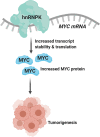The Eµ-hnRNP K Murine Model of Lymphoma: Novel Insights into the Role of hnRNP K in B-Cell Malignancies
- PMID: 33912162
- PMCID: PMC8072109
- DOI: 10.3389/fimmu.2021.634584
The Eµ-hnRNP K Murine Model of Lymphoma: Novel Insights into the Role of hnRNP K in B-Cell Malignancies
Abstract
B-cell lymphomas are one of the most biologically and molecularly heterogeneous group of malignancies. The inherent complexity of this cancer subtype necessitates the development of appropriate animal model systems to characterize the disease with the ultimate objective of identifying effective therapies. In this article, we discuss a new driver of B-cell lymphomas - hnRNP K (heterogenous nuclear ribonucleoprotein K)-an RNA-binding protein. We introduce the Eµ-Hnrnpk mouse model, a murine model characterized by hnRNP K overexpression in B cells, which develops B-cell lymphomas with high penetrance. Molecular analysis of the disease developed in this model reveals an upregulation of the c-Myc oncogene via post-transcriptional and translational mechanisms underscoring the impact of non-genomic MYC activation in B-cell lymphomas. Finally, the transplantability of the disease developed in Eµ-Hnrnpk mice makes it a valuable pre-clinical platform for the assessment of novel therapeutics.
Keywords: B-cell malignancies; Eµ-Hnrnpk; MYC; RNA-binding protein; diffuse large B cell lymphoma; hnRNP K; lymphoma; mouse model.
Copyright © 2021 Malaney, Velasco-Estevez, Aguilar-Garrido, Aitken, Chan, Zhang, Post and Gallardo.
Conflict of interest statement
The authors declare that the research was conducted in the absence of any commercial or financial relationships that could be construed as a potential conflict of interest.
Figures
Similar articles
-
Uncovering the Role of RNA-Binding Protein hnRNP K in B-Cell Lymphomas.J Natl Cancer Inst. 2020 Jan 1;112(1):95-106. doi: 10.1093/jnci/djz078. J Natl Cancer Inst. 2020. PMID: 31077320 Free PMC article.
-
A transgenic mouse model demonstrating the oncogenic role of mutations in the polycomb-group gene EZH2 in lymphomagenesis.Blood. 2014 Jun 19;123(25):3914-24. doi: 10.1182/blood-2012-12-473439. Epub 2014 May 6. Blood. 2014. PMID: 24802772
-
Bortezomib inhibits Burkitt's lymphoma cell proliferation by downregulating sumoylated hnRNP K and c-Myc expression.Oncotarget. 2015 Sep 22;6(28):25988-6001. doi: 10.18632/oncotarget.4620. Oncotarget. 2015. PMID: 26317903 Free PMC article.
-
Emerging roles of heterogeneous nuclear ribonucleoprotein K (hnRNP K) in cancer progression.Cancer Lett. 2014 Oct 1;352(2):152-9. doi: 10.1016/j.canlet.2014.06.019. Epub 2014 Jul 10. Cancer Lett. 2014. PMID: 25016060 Review.
-
Aberrant hnRNP K expression: All roads lead to cancer.Cell Cycle. 2016 Jun 17;15(12):1552-7. doi: 10.1080/15384101.2016.1164372. Cell Cycle. 2016. PMID: 27049467 Free PMC article. Review.
Cited by
-
The Role of RNA-Binding Proteins in Hematological Malignancies.Int J Mol Sci. 2022 Aug 23;23(17):9552. doi: 10.3390/ijms23179552. Int J Mol Sci. 2022. PMID: 36076951 Free PMC article. Review.
References
Publication types
MeSH terms
Substances
Grants and funding
LinkOut - more resources
Full Text Sources
Other Literature Sources
Miscellaneous



